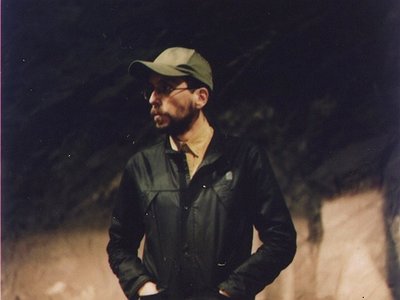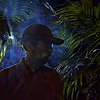Part 2
Could you describe your creative process on the basis of a piece or album that's particularly dear to you, please? Where do ideas come from, what do you start with and how do you go about shaping these ideas?
I don’t see a big part of what I do as songs, but more as series of evocations and constructions within sound in time. Catching an ongoing transmission of connections and visions and making them tangible.
Like reaching to an endless stream of variables and using different sets of optics to look at them. Particular sets of relations can be put in motion within a certain sonic “colour”: a specific acoustic space, a gesture, or a group of people within a generative process.
An example can be the album Tunnel Vision, released by SILO RUMOR. It started as a soundtrack for a film by Raz Mesinai released on Tzadik, which was re-edited into a different configuration: a 12'' vinyl. For the film we started to visit tunnels and caves in and around Porto, and soon we discovered very special places: a very deep roman mine where we found our visions and listened to the deepest tones (standing waves: a product of air passing by and a complex set of resonances). These places became so important that I made some of the recording sessions for the soundtrack / album in there, recording musicians, tones, or simply playing back the sounds I had recorded previously over and over inside the tunnel. I was very interested in letting all the sounds be contaminated by the acoustic body of those cavities, giving them a distinct acoustic imprint, and making the spaces talk through sound.
The tunnels were one stone organism that breathes underneath the surface, a presence and a sound system, the fundamental vibration that breathes through underground spaces and electricity. The analogy of a massive hidden sound system became clear; a spectral club, a place where we wanted to go and listen to this ultimate sub and to be mesmerized by the unfathomed figures he would project in our body and mind.
With more and more musicians creating than ever and more and more of these creations being released, what does this mean for you as an artist in terms of originality? What are some of the areas where you currently see the greatest potential for originality and who are some of the artists and communities that you find inspiring in this regard?
I’m not particularly interested or inspired by originality, I think “the new” can be misleading to a culture, and maybe it has more to do with the commercialization of products than creation.
I’m inspired by manifolds, so the tension points that exist between mediums (like the end of sound and the start of light, the end of a space and the start of a gesture) are a powerful trigger for working with others and for developing systems and structures that can be presented as records, stage pieces, film, light, and much more.
How strictly do you separate improvising and composing?
In my practice they are indissociable, in the sense that I tend to compose an environment in which improvisation can develop and form a body. So one element informs the other and most of the focal points immerge from that landscape.
How do you see the relationship between sound, space and composition and what are some of your strategies and approaches of working with them?
It’s a feedback relationship; they appear in a similar moment of the process, and keep conditioning and informing each other until the tension in between them becomes solid and a form emerges. Inside of this process things can shift very fast and the filter/resonance methods can be very useful to embody sounds in a distinct acoustic cavity. I have a great interest in archaeo-acoustics, how acoustics served to see beyond the present condition, extending awareness, and how this process lead to the complexity of languages and became communication.
Especially in my work with voice and choir I tend to give a massive importance to architectural resonance, where space and composition merge together to become a trigger for sound events, something that can be called a “vibrational mediation” between the guts and the environment.
What's your perspective on the relationship between music and other forms of art – painting, video art and cinema, for example – and for you and your work, how does music relate to other senses than hearing alone?
I've been always interested in all gestures and shapes, painting, and especially sculpture, were early passions: I ended up studying sculpture in university. Sound was always a tridimensional force for me, more than a bi-dimensional display of events, or a screen displaying forms. For me music was always a way of making volumes that could provoke tension, block space and condition the perception of time through form. Cinema became my main formal visual focus and therefore I find in moving images a strategy for sequencing sound, colour and context in time. My music is often built in a temporal frame, closer to cinema than to a song format.
In its deepest origins, film was an instrument of illusion (with a vibrational and flickering form). When moving image is emancipated from the narrative logic of the theatre form it can trigger a time flux very close to how I perceive music.
Stage work also became fundamental in my praxis; it’s a context where I can bring sounds, gesture, colours, ruins of narratives and archetypes to interact in a common meta-space, and still maintain the real-time element that characterizes live music and work within the specular lens of time and its manifolds.
What's your view on the role and function of music as well as the (e.g. political/social/creative) tasks of artists today - and how do you try to meet these goals in your work?
I try not to meet goals that are social abstraction or formalised expectation. There is a sense of service and mediation embedded in music and this has an intrinsic impact around us. It's a never ending set of possibilities for connecting dots, some of them have a direct impact in life others are more internal or build a different kind of perceptive lens by moving in between worlds, between elemental signals and their resonance, between language and impetus, between dissociative euphoria and intimate warmth.
Way before I’m doing it for my own pleasure (aesthetic, formal, emphatic), I sense that I’m performing a service, rendering visible something invisible that belongs to the larger community (a community that extends to non-human elements). This is very dignifying and also a responsibility.
Listening is also an active, rather than just a passive process. How do you see the role of the listener in the musical communication process?
I think that there are/were some amazing artists working within this active role (Pauline Oliveros, Maryanne Amacher and many others). Their attention is very inspiring and my personal method touches on some of their concerns.
Reaching audiences usually involves reaching out to the press and possibly working with a PR company. What's your perspective on the promo system? In which way do music journalism and PR companies change the way music is perceived by the public?
We are overwhelmed by systems of constant seduction and constraint, in all directions and layers, so the industries that surround music also work within that scope, and of course inside those places there are all kinds of people moving with their different agendas. There is also a sense of boredom that is sold constantly, so the optics are constantly shifting and it’s hard to have time to listen deeply to something, to listen beyond the form, to catch a impetus and a manifold. It's amazing when influent structures can give visibility to delicate visions and to directions that are cryptic, but because of the mechanics of these structures they will always push forward a great amount of void. Self annihilating, autophagic void.
Do you have a musical vision that you haven't been able to realise for technical or financial reasons – or an idea of what music itself could be beyond its current form?
Most of my output is already the mediation of a previous idea that by definition was wider and with a more irregular contour. Even if I tried to grasp the main driving forces of those internal pulses, many times this means that only a section of the vision is capable of being presented. I’m interested in this mutation within the formalisation, there is always some elements that stay outside, that cannot be tamed into a shape. These elements come back again and again and they start to be an unspeakable and immaterial cipher, a treasure that nourishes the output, whatever form it takes.






